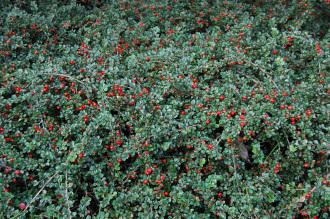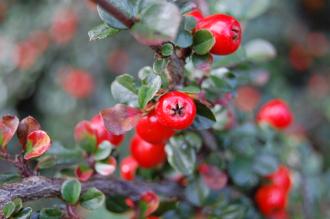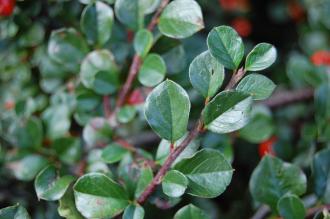
Cotoneaster apiculatus (21/10/2013, Kew Gardens, London)
Position: Full sun to light shade
Flowering period: Late spring to early summer
Soil: Moist, well drained
Eventual Height: 1m
Eventual Spread: 3m
Hardiness: 4a, 4b, 5a, 5b, 6a, 6b, 7a, 7b, 8a, 8b
Family: Rosaceae
Cotoneaster apiculatus is a deciduous shrub with a spreading, mounding habit. Its dark green glossy leaves are elliptic with entire margins, up to 15mm long and 12mm broad. Its leaves turn red/ purple in autumn before they fall. Its pink flowers are u to 5mm across. Its red fruit are pomes, up to 8mm across, mature in late summer and may be retained on the plant during the winter months. Its branches may root where they touch the ground, aiding this plant’s spread.

Cotoneaster apiculatus Berries (21/10/2013, Kew Gardens, London)
Cotoneaster apiculatus, commonly known as Cranberry Cotoneaster or Apiculate Cotoneaster, is native to south west China. In its native habitat it grows in thickets and woodland margins.
The etymological root of the binomial name Cotoneaster is derived from the old Latin name cotone meaning ‘quince and aster being a Latin substantival suffix indicating ‘resembling’. Apiculatus is likely to be derived from the Latin apicula meaning ‘little bee’, in reference to the shape of this plants leaf.
The landscape architect may find Cotoneaster apiculatus useful as an effective ground cover shrub which may be used to stabilise banks and slopes. It may also be used an an informal hedge. This shrub is tolerant of urban air pollution. It dislike hot, humid conditions. Once established this shrub is drought tolerant.
Ecologically, Cotoneaster apiculatus flowers are attractive to pollinating insects. Its berries are attractive to birds.

Cotoneaster apiculatus Leaf (21/10/2013, Kew Gardens, London)
Cotoneaster apiculatus prefers moist, fertile, well-drained soils. It tolerates most pH of soil.
Cotoneaster apiculatus requires little maintenance.

